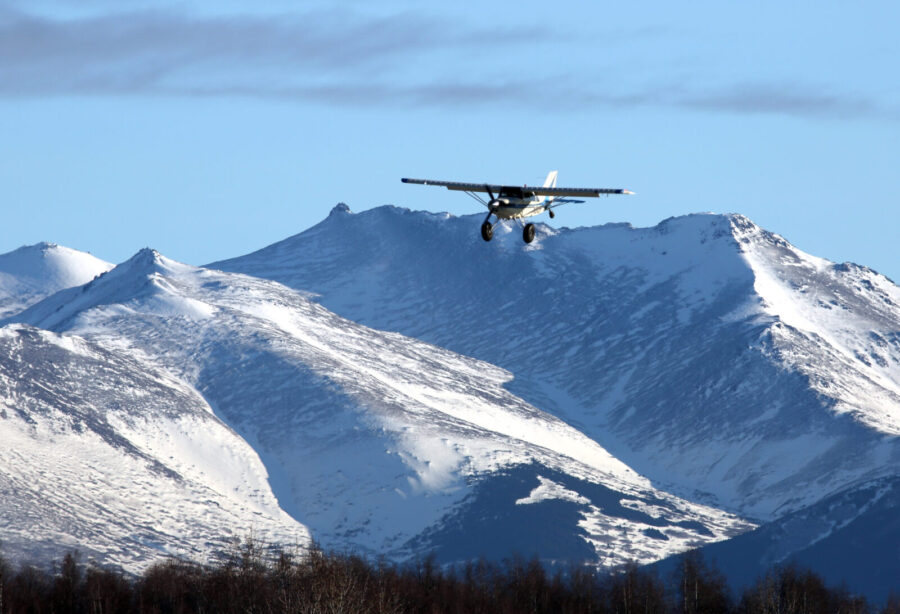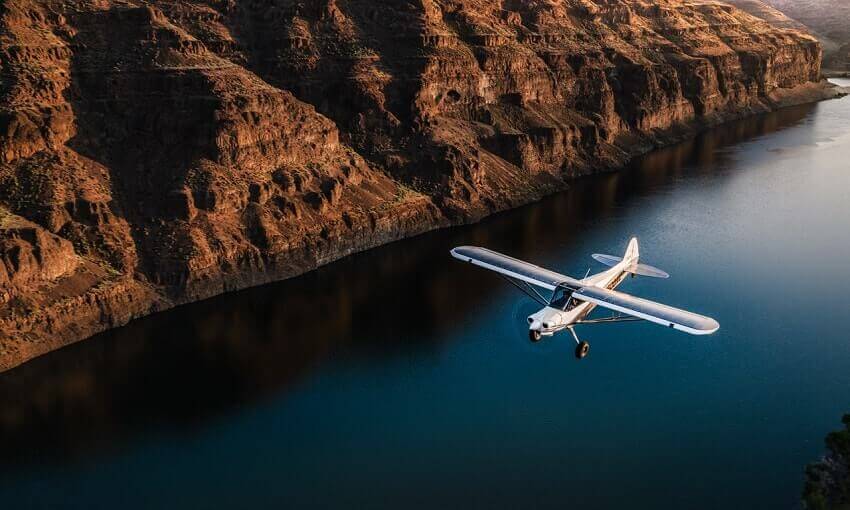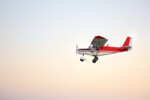Backcountry Flying: Where Can You Land a Bush Plane?
12 November 2023 | Updated on February 05, 2024
Welcome to the exciting world of backcountry flying! If you’re a thrill-seeking aviation enthusiast, you’re in for an adventure. This type of flying involves operating a bush plane in remote areas where traditional airports or runways don’t exist. It’s all about exploring untouched wilderness, mountaintops, and lakes that are off the beaten path.
But where exactly can you land a bush plane in the backcountry? In this article, we’ll explore the various locations that allow you to safely and legally touch down. Whether you’re a seasoned pilot or just starting, get ready to discover the possibilities of backcountry flying and the stunning destinations that await.

Important Disclaimer: The information and data provided here are for informational purposes only, and are subject to change over time. We strive to provide the most current and relevant information, but the dynamic nature of the topics discussed may result in changes that are not immediately reflected in our content. We recommend our readers to conduct their own research and consult with professionals when making significant decisions based on the data or information provided here. Your reliance on the information in this post is solely at your own risk.
Key Takeaways:
- Backcountry flying involves operating small aircraft in rugged and remote areas with no traditional airports or runways.
- There are various locations where you can safely land a bush plane in the backcountry, including public use airports, private airfields, registered landing sites, and off-airport landing areas.
- It’s important to familiarize yourself with local regulations and obtain any necessary permissions or permits before undertaking a backcountry flight.
- Backcountry flying offers a unique and thrilling experience for aviation enthusiasts who love adventure and exploration.
- Prioritize safety and respect local regulations to ensure a safe and enjoyable experience.
What is Backcountry Flying?
If you’re looking for a unique and thrilling aviation experience, backcountry flying may be just what you need.
Backcountry flying involves flying a small aircraft, usually a bush plane, through rugged and remote areas where traditional airports or runways may not exist. This type of flying allows pilots to explore untouched wilderness and access destinations that would be difficult or impossible to reach by other means of transportation.
Backcountry flying requires advanced piloting skills and a deep appreciation for nature and adventure. The pilot must have excellent control of the aircraft, be familiar with the terrain, and have the ability to make quick decisions in case of unexpected developments.
There is no doubt that backcountry flying is a challenging activity that requires significant preparation and planning. However, the reward of accessing some of the most beautiful and remote parts of our planet is a truly unique and unforgettable experience.
Whether you are an experienced pilot or a beginner, a love for adventure and exploration is all you need to enjoy the thrill of backcountry flying.
Public Use Airports and Airstrips
If you’re a backcountry pilot, one of the most dependable options for landing your bush plane is at public use airports and airstrips. These designated landing areas are maintained by government agencies or local communities, ensuring safe and reliable access to remote areas.
Public use airports can be found in various locations such as national parks, state parks, and wilderness areas, providing incredible opportunities to explore stunning natural landmarks. These airports offer a range of services, including fueling and maintenance facilities, making them an ideal choice for backcountry pilots.
It’s worth noting that while public use airports generally have fewer restrictions, they still require pilots to exercise caution and adhere to local regulations. Pilots should familiarize themselves with the specific airport requirements and be prepared to adapt to changing weather conditions and other factors that may impact safety.
Overall, public use airports and airstrips are a fantastic option for backcountry pilots seeking a safe and reliable landing location. Whether you’re exploring a national park or flying over a remote mountain range, public use airports provide a great starting point for your next backcountry adventure.
Private Airfields and Registered Landing Sites
If you’re looking for a more secluded and personalized backcountry flying experience, private airfields and registered landing sites are an excellent option. These locations are often owned by individuals or organizations that permit pilots to use their facilities. While they may not have the same level of infrastructure and regulations as public use airports, they offer a unique opportunity to explore remote areas.
Private airfields can range from simple grass strips to elaborate facilities with hangars, fuel services, and other amenities. These locations are typically more flexible and accommodating to pilots, allowing for a more personalized experience. It’s important to note that some private airfields may require advanced notice or permission before landing, so pilots should be sure to research and coordinate their travel plans accordingly.
Registered landing sites are another option for backcountry flyers. These locations are designated by government agencies or local communities as suitable for landing small aircraft. Registered landing sites may have limited amenities, but they offer a regulated and safe environment for pilots to explore and enjoy the wilderness.
| Private Airfields | Registered Landing Sites |
|---|---|
| Owned by individuals or organizations | Designated by government agencies or local communities |
| May require advanced notice or permission to land | Offer a safe and regulated landing environment |
| More flexible and accommodating to pilots | May have limited amenities |
Whichever landing option you choose, it’s important to prioritize safety, respect local regulations, and have a thorough understanding of the specific landing site before embarking on a backcountry flight.


A bush pilot makes a landing at Lake Hood in Anchorage Alaska. The large wheels on the plane give the ability to land on difficult terrain.
Off-Airport Landings
If you have experience with backcountry flying and are looking for an even more adventurous challenge, off-airport landings may be for you. These types of landings require advanced skills and knowledge of the specific terrain to ensure safety. Pilots must carefully evaluate the area for landing, including any obstacles, wind conditions, and the condition of the terrain.
Off-airport landings can be made in a variety of locations, including snow-covered fields, gravel bars, and even riverbanks. However, it is important to note that landing in unprepared areas can be dangerous and should only be attempted by experienced pilots.
When planning for an off-airport landing, it is crucial to thoroughly inspect the landing area and consider any potential hazards or obstacles, such as rocks, trees, or uneven terrain. Pilots should also be aware of the wind conditions and plan their landing approach accordingly. It’s important to keep in mind that off-airport landings are not legal in all areas, so pilots should always research and obtain any necessary permissions or permits before attempting this type of landing.
Regulations and Permissions
When it comes to backcountry flying, it’s essential to be aware of the regulations and permissions for landing in remote areas. Different locations may have specific requirements or restrictions, especially when it comes to landing in protected wilderness areas or national parks. As a responsible pilot, it’s crucial to prioritize safety and respect local regulations to ensure a positive and sustainable experience for everyone.
Before planning a backcountry flight, research the specific landing locations’ regulations to understand any restrictions, requirements, or permits needed. This may include obtaining permission from landowners or local authorities, registering your flight plan, or adhering to specific landing procedures.
One example of a regulation is the Federal Aviation Administration’s (FAA) rules for landing in wilderness areas. According to the FAA’s guidelines, pilots are required to obtain permission from the managing agency, follow designated flight paths, and adhere to specific flight altitudes to minimize environmental impact.
Additionally, pilots should be aware of any noise restrictions or wildlife protection regulations in the area. For example, if you plan to land near a wildlife sanctuary, you may be required to reduce engine noise levels or avoid landing during specific times of the year when animals are breeding or nesting.


Types of Permits and Permissions
The type of permits or permissions required will vary depending on the location and the type of landing. Pilots may need to obtain permits from government agencies, private landowners, or local communities.
For example, in national parks, pilots may need to obtain a special use permit from the National Park Service to land in designated areas. These permits help manage the number of aircraft in the area, minimize environmental impact, and ensure visitor safety.
Private landowners may also require permission before landing on their property. Pilots should respect private property rights and obtain permission in advance to avoid trespassing violations.
It’s important to note that failure to adhere to local regulations or obtain necessary permits can result in fines or penalties. By respecting regulations and obtaining the appropriate permissions, pilots can ensure a safe, enjoyable, and sustainable backcountry flying experience.
Conclusion
Backcountry flying is an exciting and adventurous way to explore remote areas and access locations that aren’t easily reachable by conventional means. Whether you choose to land at public use airports, private airfields, registered landing sites, or venture into off-airport landings, the possibilities for exploration are endless.
As you plan your backcountry flight, it’s important to prioritize safety and be familiar with the local regulations and permissions. Ensure you have all the necessary permits, and have a solid understanding of the specific terrain where you plan to land your bush plane.
With the right knowledge and preparation, backcountry flying can be an incredibly rewarding experience, allowing you to access breathtaking natural landscapes and immerse yourself in the spirit of adventure. So pack your bags, buckle up, and prepare for an unforgettable flight!
FAQ
Where can you land a bush plane for backcountry flying?
There are several options for landing a bush plane in the backcountry. You can utilize public use airports and airstrips, private airfields, registered landing sites, or even make off-airport landings in unprepared areas like gravel bars and snow-covered fields.
What is backcountry flying?
Backcountry flying refers to operating a small aircraft, usually a bush plane, in rugged and remote areas where traditional airports or runways may not exist. It allows pilots to explore untouched wilderness, lakes, mountaintops, and other off-the-beaten-path destinations.
What are public use airports and airstrips?
Public use airports and airstrips are designated landing areas maintained by government agencies or local communities. They provide a regulated and safe environment for pilots to land their bush planes in backcountry areas, including national parks and wilderness regions.
Can I land at private airfields and registered landing sites?
Yes! In addition to public use airports, backcountry pilots can also land at private airfields and registered landing sites. These locations are typically owned by individuals or organizations that permit pilots to use their facilities, offering a more secluded experience with potentially fewer restrictions.
Is it possible to make off-airport landings?
Absolutely! Backcountry flying allows for off-airport landings, which means landing a bush plane in unprepared areas like gravel bars, snow-covered fields, or riverbanks. However, it’s important to have advanced skills and knowledge of the specific terrain to ensure safety.
What regulations and permissions should I consider?
When planning a backcountry flight and choosing a landing location, it’s crucial to consider the applicable regulations and permissions. Different areas may have specific requirements or restrictions, particularly in protected wilderness areas or national parks. Make sure to familiarize yourself with the local regulations and obtain any necessary permits or permissions before embarking on a backcountry flight.

































